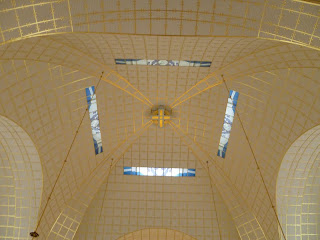A hundred years ago, Vienna was culturally a very exciting place. In reaction to the dominant conservatism of the late Austro-Hungarian Empire, an avant-garde of artists, architects and composers experimented with new aesthetics ranging from Egon Schiele's erotic expressionism to Adolf Loos' upright austerity. This mood was most famously embodied by Jugendstil or "Youth Style," the Central European branch of Art Nouveau which found support from an enthusiastic segment of the bourgeoisie. Thus, so the legend goes, fast-growing pre-WWI Vienna was a crucial laboratory of early Modernism.
Of course, most legends of energetic fin-de-siècle capitals make innovative culture sound like a widespread expression of an enlightened moment, when it was in most places a rather edgy, minor (though not marginal) phenomenon. Thus Frank Lloyd Wright indeed had a thriving practice in contemporaneous Chicago, but most houses in that booming town were still decidedly traditional; and while Paris' metro station entrances are indeed writhingly Art Nouveau, similarly-styled apartment buildings, though found all over the city, need to be distinguished from their more numerous academic-classical neighbours.
The same can be said for Vienna, but nonetheless I was surprised at how much more of the city is of century-old avant-garde stock, compared with Paris, Chicago, and elsewhere I've seen. (Prague, however, has Vienna beat in this regard, but that's another story...) It seemed hard in the nineteenth-century districts of Vienna to find a street without several Jugendstil buildings, no matter how modest their ornamentation. A number of the finest examples are by Otto Wagner, one of those architects with a rare combination of talent, vision, professional skill and sheer luck, attaining the top of his profession and respected in nearly every way. Wagner's prolific contribution to Vienna was, without exaggeration, frequently evoked by my co-host as we explored the streets: "Here is an Otto Wagner house ... Here is another Otto Wagner house ... These railings were designed by Otto Wagner ... All the metro stations on that line are by Otto Wagner ... This ring of roads was planned by Otto Wagner," and so on.
For all of Vienna's beautiful old central district and pompous nineteenth-century monuments, then, it has enough Jugendstil to make the city appear elegantly progressive.
These are some well-known buildings mixed in with some of the other random details that caught my eye. This is another long post, by the way.
Here's a paired apartment building by Otto Wagner. The stair hall's stair treads are surprisingly gentle to climb.
The famous retail and apartment building by Adolf Loos.
The amazing Kirche am Steinhof by Wagner, on a wooded hill overlooking Vienna.
Details of the Vienna Secession building by Joseph Maria Olbrich.
A pedestrian bridge passes over a metro bridge, a kind of metropolitan urban composition by Otto Wagner.
... And the Wagner railings seen all over the city.
Wagner's beautiful and iconic Post Office Savings Bank.
A Wagner metro station entrance pavilion.
An Adolf Loos-designed shop.
The Adolf Loos-designed bar! The interior is dark and exquisite, all wood and leather and marble and mirror, and made me realize how much Loos prefigured Art Deco.








































































ahh super!
ReplyDeletepoor camillo sitte, having a hissy fit ...
Yeah, no charming little Italian squares here.
ReplyDelete